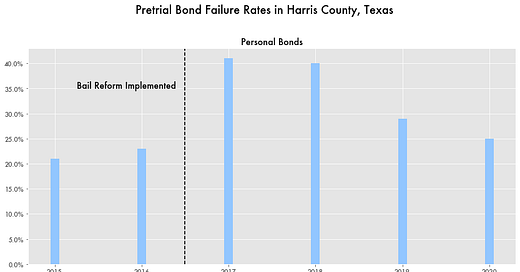Rearrests and Bond Failures Since Bail Reform
Criminal justice reform advocates have touted the success of recent bail reform measures across the country. Places like New York, Chicago, and Houston have seen little recidivism during the pretrial period—crimes committed between when a defendant in arraigned and when they are brought to trial—because the accused was released from prison rather than detained without having to post money for a cash bond.
Eliminating cash bail has been seen as a win-win: for both the criminal justice system who can avoid the costs and burden of pre-trial detention, and for the non-guilty defendants who could not afford bail and would have their lives upended by being detained.
But the picture may be more complicated than that. Houston has seen a discernible increase in bond failure rates since reform, and New York has seen substantial rearrests of those released in the pre-trial period contrary to what the city government had previously said. And the situation in Chicago may be less clear than previously reported.
Houston
In Houston, the rate of bond failures for non-cash personal bonds—wherein a defendant doesn’t pay money for pre-trial release but will owe money if they don’t show up—would go from around 21 percent percent in 2015 to over 40 percent in 2017 following bail reform in Harris County. Bail reform in the county led to more defendants being given lower bail restrictions like non-cash personal bonds.
The county would also see re-offense by those on pretrial release go from 53 to 56 percent pre-reform to around 80 percent afterwards.
New York City
As first reported by The City, those released on non-monetary bail would see a significant rearrest rate—23 percent would be rearrested for felonies and 41 percent would be rearrested for any type of crime according to New York pre-trial data between 2020 and 2022.
Previously, the mayor’s office touted an 8 percent rearrest rate in 2019. A 2022 NYC comptroller report promoted a 5 percent rearrest rate following reform.
The data also shows an impressive 90 percent of arrestees would be issued a bench warrant—usually a citation for a violation of probation or not showing up to court.
Not only is that a large rearrest rate compared to cash bail, it appears to be particularly high level when compared with historical data. A Bureau of Justice Statistics (BJS) study of pretrial released between 1990 and 2004 from the 75 largest counties in the U.S. showed that, of those released on their own recognizance, 17 percent were rearrested, 26 percent failed to appear in court, and 8 percent remained fugitives—much lower than New York’s 41 percent rearrest rate.
Chicago
In Chicago, it was General Order GO18.8A that reformed the bail system to prioritize the use of non-monetary I-Bonds, decreased monetary requirements, and released more individuals during the pre-trial period “all without affecting new criminal activity of those released or increasing crime,” according to a 2021 Safety and Justice Challenge report. The report also states that failures to appear in court went up significantly, by about 3 percent.
But Chicago’s experiment with bail reform is complicated to measure as it occurred at the same time the city experimented with criminal justice reform. While the Chicago court system has touted an 8 percent decline in violent crime following bail reform in 2018, that also occurred after a random spike in violent crime, particularly homicide.
The data is complicated by the fact that the Chicago Police Department stopped producing annual reports between the years of 2011-2016 when violent crime spiked. Between 2014 and 2016, the number of murders in the city would almost double, from 415 to 768 a year.
While Chicago didn’t publish data those years, the numbers on arrests and incidents are available in the Federal Bureau of Investigation’s (FBI) Uniform Crime Reporting (UCR) data. That data shows the higher rate of homicides and violent crime in the period following bail reform.
Chicago and Criminal Justice Reform
Additionally, the bail reform period data happens during the same time as Kim Foxx’s start as Cook County’s district attorney in 2016. Foxx would actively cease prosecuting a wide variety of cases including homicide, and the clearance rate in Cook County—the rate of cases processed by the courts—would drop sharply during her tenure.
If cases are dropped, then those cases would not affect failure-to-appear rates and potentially rearrest rates.
Washington, D.C.
D.C. may have been the first to enact bail reform when it did so back in the 1990s. As a result nearly 88 percent of defendants are released pre-trial without having to procure a cash bond according to the Justice Policy Institute.
D.C. has called bail reform a success, highlighting a 12 percent rearrest rate. Only 15 percent had their release revoked for pre-trial offense such as failing to appear in court.
But D.C.’s experiment with bail reform has gotten renewed attention with the recent attack on Congressman Angie Craig (D-MN) by someone with 25 outstanding bench warrants—a warrant for violation of court orders such as failure to appear.






